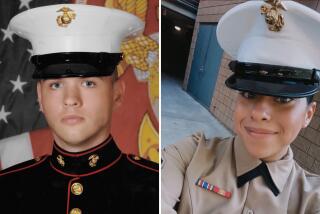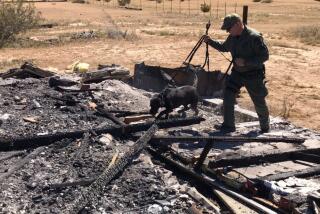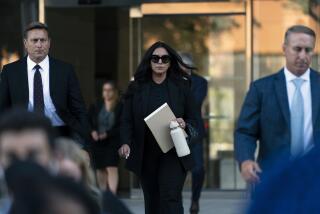Kraft Defense Says Marine Found in Car Was Not Dead
- Share via
The first signs of Randy Steven Kraft’s defense in his trial on 16 murder charges emerged Tuesday when his attorney challenged prosecutors’ contention that a Marine found in Kraft’s car when he was arrested five years ago was actually dead.
“Of course he wasn’t dead,” defense attorney C. Thomas McDonald said outside the courtroom Tuesday.
McDonald pointed to police testimony he believes shows that the body of the Marine, 25-year-old Terry Lee Gambrel, was not cold when he was found by two California Highway Patrol officers in Kraft’s car. McDonald also points to activity that night from paramedics and hospital officials that he argues shows “viable” signs of life in Gambrel.
“You do not have to have a pulse or a heart beat to have viability,” McDonald said.
But what does this mean for Kraft, who is accused of drugging Gambrel, tying his wrists with the Marine’s own shoelaces, then strangling him to death with the man’s own belt?
Although prosecutors argue that Gambrel was already dead, even if he was just short of death, they contend, he was still one of Kraft’s victims.
“That will come out in due time,” McDonald said. “Right now, we’re just taking this case one step at a time; we have a long way to go.”
The crowd in Superior Court Judge Donald A. McCartin’s Santa Ana courtroom Tuesday was just half what it had been Monday for opening statements in the trial, which is expected to take about a year to complete.
Kraft, now 43, a Long Beach computer consultant, faces a possible death penalty if convicted. Prosecutors have filed court papers accusing him of a total of 45 murders of young men in the Southland, as well as in Oregon and Michigan.
Deputy Dist. Atty. Bryan F. Brown has told the 10-woman, two-man jury that he plans to present evidence on the 16 murders in descending order, beginning with Gambrel, found May 14, 1983, and ending with Edward Daniel Moore, a 20-year-old Marine found Dec. 26, 1972, the earliest of the 16 Orange County murder charges against Kraft.
Prosecutors say they will introduce anywhere from 21 to 29 other murders against Kraft if he is convicted, which would force his trial into a separate death penalty phase trial.
In other Kraft-related events, Judge McCartin finally agreed to a request from the Orange County Register that he release questionnaires completed by jurors. But the judge first gave the jurors the right to censor any or all of their answers.
A summary of the questionnaires from the 12 regular jurors shows a variety of answers to basic questions about their backgrounds and viewpoints. For example:
- All but one claims to be a regular voter.
- All are at least high school graduates, and five of the 12 have at least some college experience.
- Only half said they watched the television news show “60 Minutes.”
- All agreed that not every murder case should be treated the same.
- All but two had read about the Kraft case in newspapers, but none of them said they had read a lot about it.
McCartin recently observed from the bench that he was surprised at how little these jurors did know about the case.
None of the 12 appeared to be fervent in views on the death penalty. Although most did say the death penalty was appropriate in some cases, they gave a variety of responses.
Juror Debora Ann Garcia, 30, answered: “I myself cannot take another man’s life, but I also can’t see him rot in jail forever. I don’t know how I feel about it.”
Juror Marcia K. Congdon, 34, said she supports the death penalty if the crime was “hideous.”
“I believe the person who committed the crime should also suffer,” she added.
Carol M. Neal, 33, said that she could support a death penalty in some cases, but added that she does not believe that it is a deterrent to crime.
Juror Sandra K. Dyer, 40, at one point in the questionnaire said “we are only instruments through which God moves.” She also said that in most cases she would probably be inclined toward a life without parole sentence instead of death.
Juror Tracie Metzner, who at 25 is the youngest on the jury, said the death penalty should be reserved for “serious and grisly murders, where the defendant has no conscience or guilt.”
The jurors, cautioned by lawyers on both sides to take careful notes, have kept busy writing and keeping up with testimony from half a dozen witnesses called to the stand during the first two days.
On Monday, Michael Sterling, the CHP officer who first arrested Kraft, testified that the defendant told him that he had picked up Gambrel hitchhiking. It was Sterling’s sergeant, Michael Howard, riding in the patrol car with him, who first discovered something was wrong with Gambrel.
Both officers have said emphatically that Gambrel was dead.
Howard testified Tuesday that after Kraft was arrested and placed in the back of the patrol car, he asked them: “How’s my friend?”
Prosecutor Brown has been leading the jurors through events in the order in which they occurred. Paramedics and the first of other officers on the scene followed Howard to the witness stand Tuesday.
Today’s first witness will be Dr. Robert Richards, a forensic pathologist and a partner of the late Dr. Walter Fischer, who performed the autopsy on Gambrel. Prosecutors are using Richards as a way to put Fischer’s autopsy findings on Gambrel in front of the jury.
More to Read
Sign up for Essential California
The most important California stories and recommendations in your inbox every morning.
You may occasionally receive promotional content from the Los Angeles Times.










